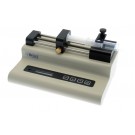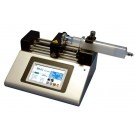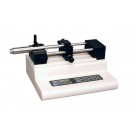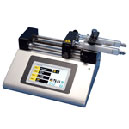
BE THE FIRST TO KNOW
Enter your email below to subscribe to the QLA newsletter to receive timely updates from your favorites products.
 |
Infusion Only PumpsDelta 1000 Syringe PumpThe simplest type of syringe pump is an infusion only pump. That means that the syringe plunger is pushed forward by the motor to deliver the liquid. At the end of the run, the syringe must be refilled manually and the pump re-set for the next run. Pumps may control a single syringe, two syringes, or a multiple syringe rack. Where more than one syringe is used, the flow may be split into any number of channels, or combined into a single channel. For example, a pump running at 10mls/min with one syringe, could deliver 40mls/min with 4 syringes of the same size in series, with the flow lines combined into one. Or they can deliver 2 x 20mls/min or 4 x 10mls/min. |
 |
Infusion/Withdrawal PumpsThese types of pumps generally perform exactly the same function as an infusion pump, but at the end of the run, the motor reverses and the syringe plunger moves in the opposite direction causing the syringe to fill again. Sigma Infusion/Withdrawal PumpThese are extremely versatile pumps as they can also be used in infusion only mode where required to simply deliver liquid. Infusion/Withdrawal pumps may also be used in withdrawal only mode, so the syringe is essentially only filling with liquid or air and not dispensing. If a suitable simple valving system is used, a syringe can be automatically refilled from a reservoir, so that infusion is followed by refill and followed by infusion again and so on. This means that a simple pump can repeatedly deliver liquid over and over again. Because the syringe is required to move in both directions in this type of pump, the plunger needs to be clamped rigidly so that it can move both ways, and the syringe barrel itself must not move. Not all syringes are suitable for this kind of pump although the majority are. |
 |
Push/Pull & Continuous Flow PumpsPush/Pull pumps are a variation of the infusion withdrawal pump, except that the syringes are opposing each other. That means that one syringe faces one way and the other faces the opposite direction, with the tops of their plungers clamped at the same place. As one syringe is infusing, the other is withdrawing at the same rate. This kind of pump can be used for liquid exchanging or creating a continuous flow with a series of valves so that each side is pulling from a reservoir and delivering to another location. For this reason Push/Pull Pumps are often called Continuous Flow Pumps. |
 |
High Pressure PumpsBecause syringe pumps are controlled by a rotating screw thread driven by a motor, they will deliver a fixed amount of linear force. The amount of pressure that force Delta 4100 High Pressure Pumpwill translate into is dependent on the diameter of the syringe. A small diameter syringe will generate a much higher pressure than a wide diameter syringe. However, glass and plastic syringes are not designed to operate under high pressure and that can be dangerous also, and so stainless steel syringes are often used. Even so, the majority of syringe pump applications do not require a very high pressure and so the motors used are not designed to deliver a great force. In this case a higher force motor is used which is capable of delivering a much higher pressure, but even here it is always a trade-off between pressure and syringe size. |
 |
Low Flow Rate Pumpshe precision with which a syringe pump will deliver an amount of liquid is dependent on a number of factors. The forward movement of a syringe plunger is dependent Sigma1800 Nano Pumpon a screw thread being turned by a motor. The number of steps in a single rotation of the motor and the pitch of the screw thread will determine how far the plunger moves for each motor step. The more steps and the finer the threads, the less the plunger will move and the more smoothly it will move. For small syringes with a narrow diameter, these steps are magnified, and so for a low flow rate it is better to have a dedicated pump which is designed to operate within a more narrow flow rate range than conventional pumps. The precision and accura |